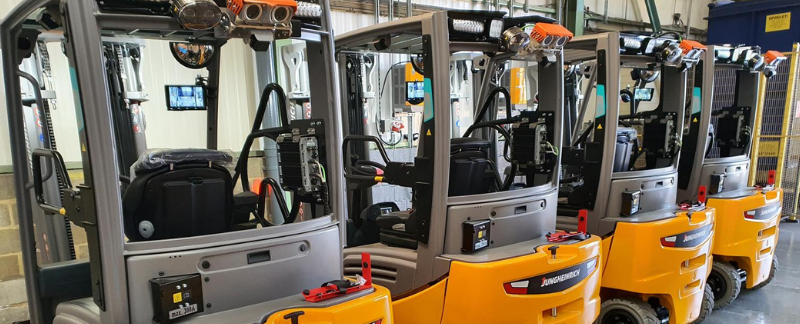Choosing the Best Forklift Fleet Management Software
Efficient forklift fleet management is critical for safety, productivity, and cost control across industries like logistics, construction, and warehousing. With growing demands and stricter safety regulations, choosing the right forklift fleet management software can streamline operations, reduce downtime, and prevent accidents.
The Growing Importance of Forklift Fleet Management
In today’s fast-paced industrial landscape, managing a fleet of forklifts is no longer a matter of convenience, it’s a critical operational necessity. Warehouses, manufacturing plants, and logistics centers all rely heavily on forklifts to move goods efficiently and safely. However, without the proper systems in place to track and monitor these machines, businesses can face rising operational costs, unplanned downtime, and even higher risks of workplace accidents.
Fleet management software has emerged as a game-changer. It provides real-time data on vehicle usage, operator performance, and maintenance schedules. With a comprehensive and advanced fleet management system, companies can streamline operations, improve safety and productivity, ensure compliance with safety standards, and significantly reduce unnecessary expenses.
Whether you manage a small local warehouse or a vast international logistics network, investing in fleet management software is a strategic move that pays off in both the short and long term.
What is Forklift Fleet Management Software?
Forklift fleet management software is a sophisticated digital platform that allows companies to track, monitor, analyze, and optimize the performance of their entire forklift fleets. By leveraging technologies such as IoT (Internet of Things), telematics, AI-driven analytics, and cloud computing, these systems provide a centralized overview and valuable insights into fleet’s health, efficiency and activity.
A modern forklift fleet management system typically enables businesses to:
- Track real-time location and movement of forklifts, providing visibility into asset usage across facilities.
- Monitor operator behavior, including adherence to safety protocols, driving patterns, and incidents like collisions or abrupt stops.
- Automate maintenance scheduling to reduce unexpected downtime, helping to prevent unexpected downtime and breakdowns by addressing mechanical issues before they become major problems.
- Analyze energy or fuel consumption, contributing to both cost savings and environmental sustainability.
- Optimize fleet utilization, identifying underused assets and opportunities for reallocation or reduction.
With all of these functionalities integrated into one platform, forklift management software empowers operations managers to make data-driven decisions that improve efficiency and safety across the board.

Key Features to Look for in Forklift Management Software
Real-Time Tracking and Telematics
A good forklift management system should offer GPS tracking, geofencing, and telematics integration. These features help businesses monitor forklift movements, prevent unauthorized usage, and enhance safety.
One of the most essential features of any forklift management system is real-time tracking through GPS, geolocalization and telematics integration. This capability help businesses:
- Locate each forklift instantly
- Set geofencing parameters to control where forklifts can operate
- Detect and prevent unauthorized or unsafe vehicle usage
- Monitor key metrics such as usage time, idle time, and travel paths
- Enhance safety and productivity
Solutions like Blaxtair Connect combine telematics with safety systems, providing an added layer of intelligence for tracking both machine and pedestrian interactions in real time.
Operator Performance Monitoring
Advanced software provides data on operator behavior, including speed monitoring, impact detection, and safety compliance. This helps reduce accident risks and improves accountability among drivers.
The forklift operators play a key role in the overall performance of a fleet. Monitoring how they operate the equipment can lead to significant improvements in safety and efficiency. Advanced software solutions provides data such as:
- Shock detections
- Speed monitoring and harsh braking notifications
- Operator ID tagging for accountability
- Customizable safety compliance reports
These features encourage safe driving behavior and help identify training needs, ultimately reducing the risk of workplace incidents.
Predictive Maintenance and Diagnostics
Downtime is one of the biggest threats to productivity in any warehouse. Predictive maintenance tools use AI algorithms and machine learning to analyze historical data and identify patterns that suggest upcoming mechanical issues. With this feature, businesses can:
- Schedule maintenance during low-activity hours
- Fix problems before they escalate
- Extend the lifespan of their forklifts
- Minimize emergency repair costs
- Ensure safety and compliance through consistent upkeep
Customizable Dashboards and Reporting
Data is only useful if it’s accessible and actionable. A user-friendly interface with real-time dashboard analytics and visual reporting tools is crucial. Businesses should choose forklift management software that offers:
- Custom KPIs and alerts
- Exportable reports (on fleet efficiency, cost analysis, and compliance tracking) for management and audits
- Visualization tools to track trends and spot anomalies
- Integration with mobile apps for on-the-go access
This level of insight gives managers the ability to act quickly, adjust strategies, and keep operations running smoothly.
Benefits of Implementing Software for Forklift Fleet Management
Increased Safety and Compliance
Forklift-related accidents can lead to severe injuries, legal consequences, and reputational damage. By using forklift fleet management systems to monitor operator behavior and track incidents, businesses can reduce accidents and foster a safer working environment. These systems also assist in complying with regulations such as OSHA (Occupational Safety and Health Administration) guidelines, reducing the risk of costly fines and liability.
Reduced Operational Costs
Through optimized fleet utilization, predictive maintenance, and fuel efficiency tracking, companies can significantly lower operational expenses. Businesses can minimize downtime and prevent unnecessary repairs with forklift software. Fewer breakdowns mean less unplanned downtime, and smarter scheduling ensures that fleets are always operating at peak efficiency.
Moreover, by identifying underused vehicles or inefficient routes, businesses can make informed decisions on whether to downsize, redistribute, or upgrade their equipment, leading to long-term savings.
Improved Productivity and Efficiency
Manual tasks like scheduling maintenance, logging operating hours, or compiling reports can consume valuable time. Forklift fleet management software automates these routine tasks, allowing teams to focus on higher-value operations and on strategic initiatives.
Additionally, by having instant access to performance metrics, managers can detect bottlenecks, reassign equipment as needed, and ensure resources are allocated effectively.
How to Choose the Right Forklift Fleet Management System
Selecting the best forklift management system requires evaluating specific business needs. Consider the following factors when making a decision:
- Scalability – Ensure the software can grow with your business and accommodate an expanding fleet.
- Integration Capabilities – The system should seamlessly integrate with existing warehouse management and ERP software.
- User-Friendly Interface – A simple and intuitive design allows for easy adoption by operators and managers.
- Advanced AI & Data Analytics – Smart reporting and AI-driven insights enhance decision-making and operational efficiency.
Future Trends in Fleet Management
The evolution of AI, IoT, and machine learning is shaping the future of forklift software. Emerging trends include:
- Autonomous forklifts: AI-driven navigation systems are enabling forklifts to operate independently, coordinating with each other for optimized task completion.
- Cloud-based fleet management: Cloud technology allows for real-time remote monitoring and control from anywhere in the world, improving responsiveness and operational oversight.
- Advanced safety features: New features like AI-powered pedestrian detection, automatic speed limitation in high-risk areas, and dynamic route optimization are elevating workplace safety to unprecedented levels.
As these innovations continue to develop, companies that embrace them early will be well-positioned to lead the way in operational excellence and safety compliance.

Conclusions
Investing in forklift fleet management software is essential for businesses aiming to improve safety, reduce costs, and enhance efficiency. By choosing a system with real-time tracking, predictive maintenance, and AI-powered analytics, companies can gain a competitive edge in warehouse and logistics management.
Whether your goal is to reduce costs, boost productivity, or create a safer work environment, choosing the right software can help you achieve it all.
Ready to upgrade your fleet operations?
To discover how Blaxtair’s innovative solutions can help transform your forklift fleet management, contact us today and take your safety and efficiency to the next level.
